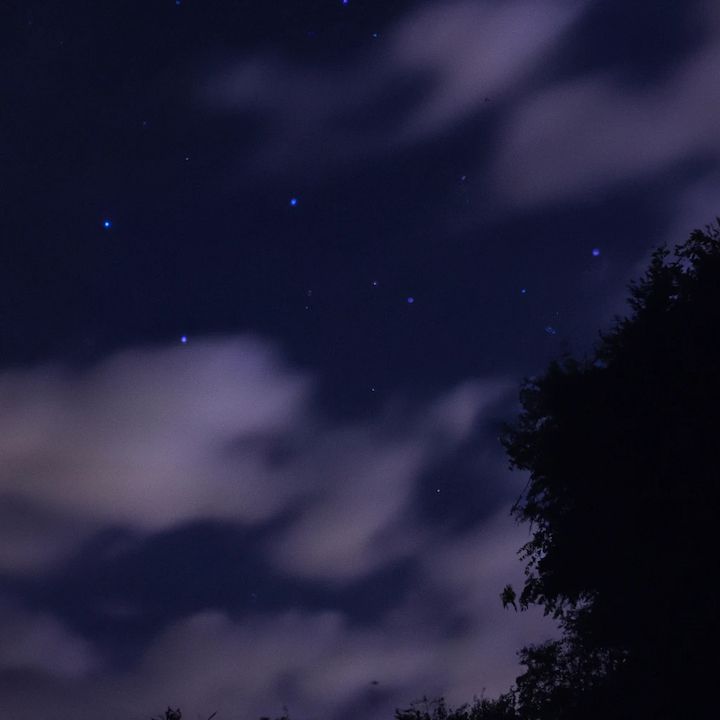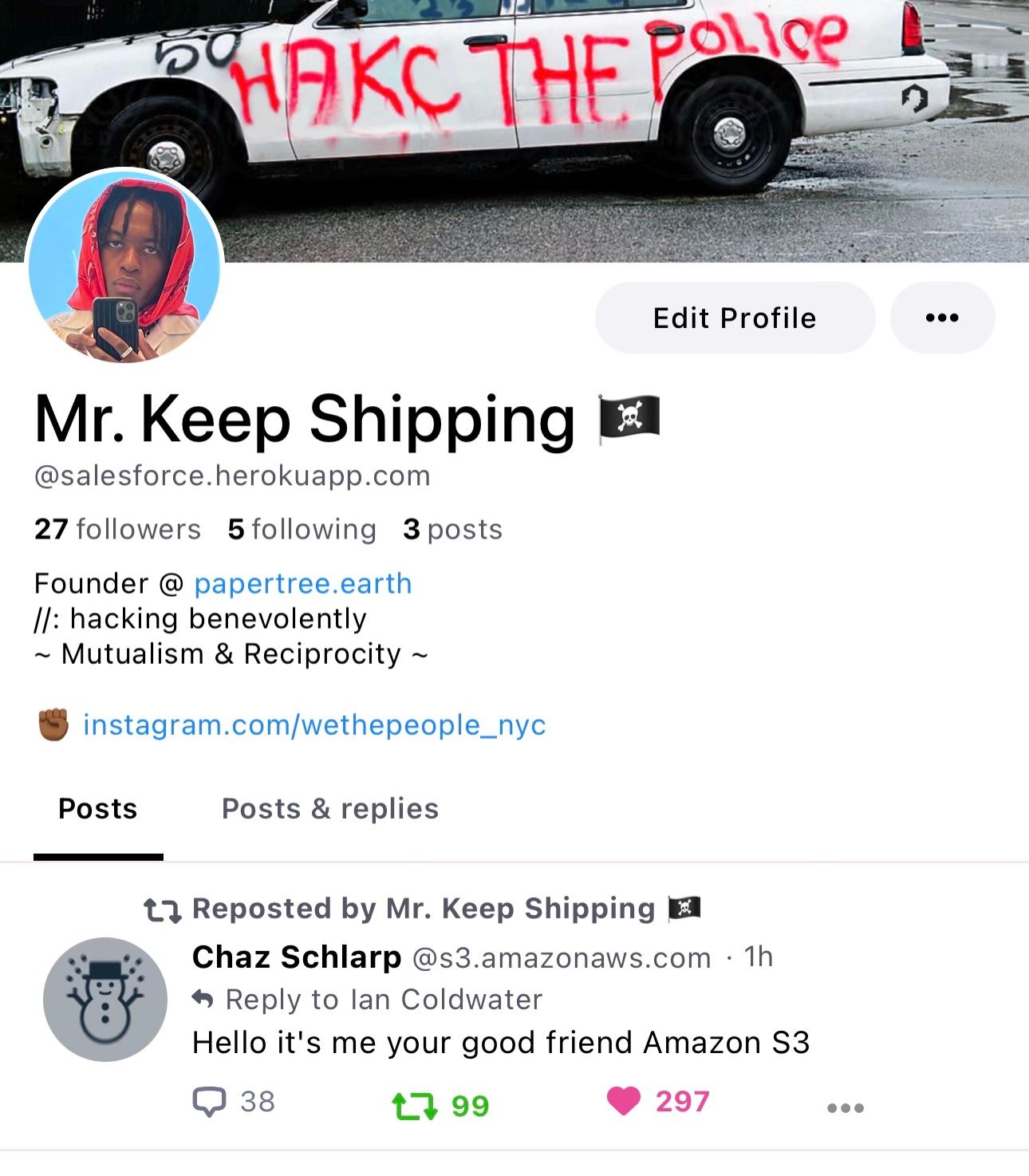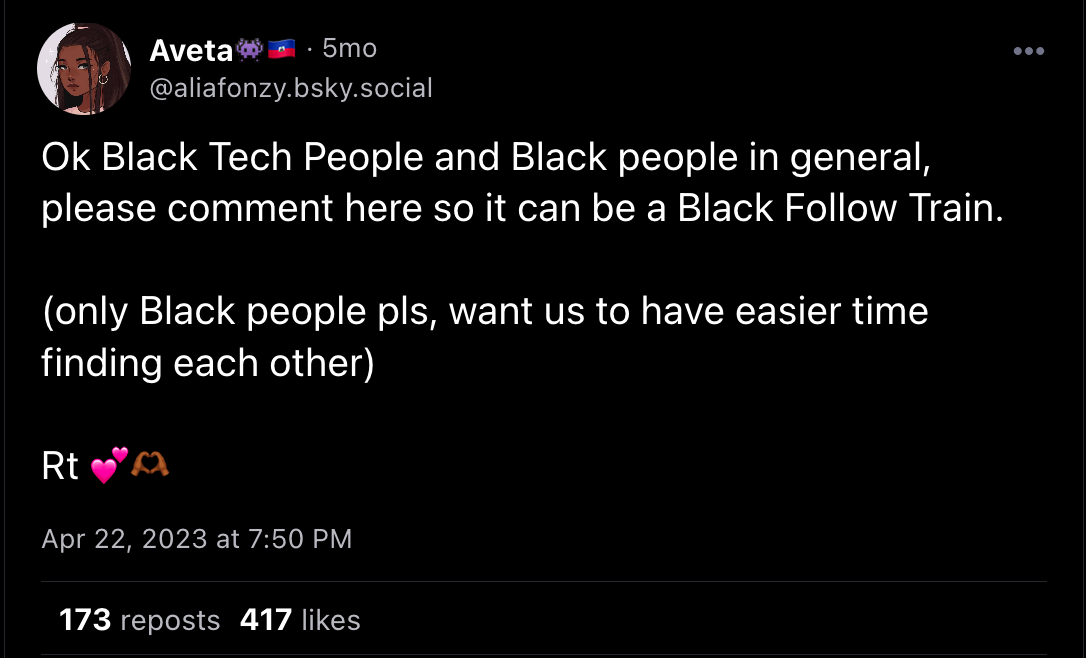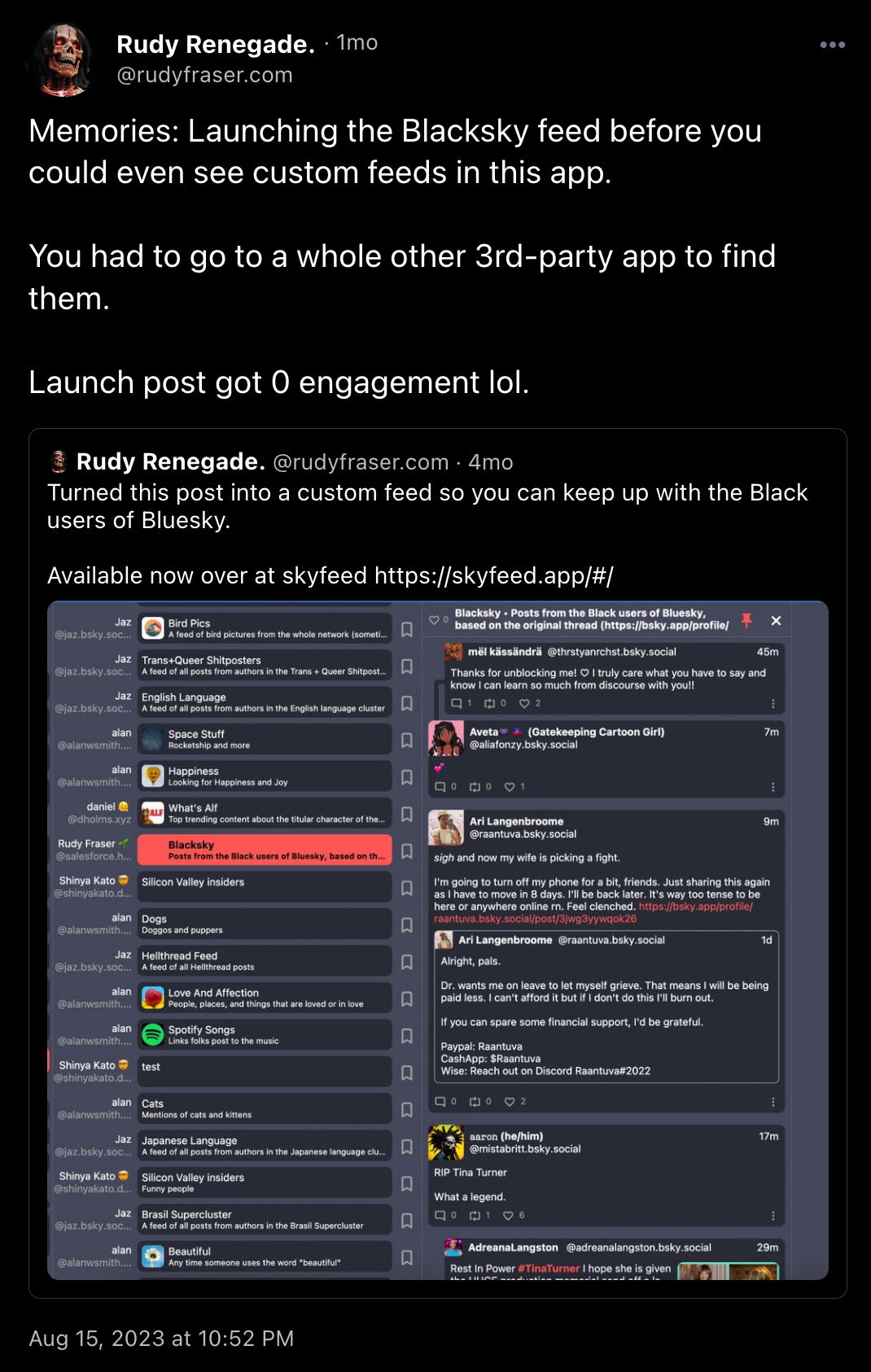Blacksky: Expressing the Black Everyday in a New Digital Space (Part 1)
I felt too young, and too cool, and too Black to be on Bluesky.

If you've found your way to this article, you're probably already vaguely aware of what Blacksky is. Maybe you have some misconceptions – popular ones being that it's some coordinated collective, another that it's just akin to a Twitter list. But you at least get the gist that it's something to the effect of "Black people on Bluesky". In fact, its very intention was to become Black Twitter for Bluesky, even before my involvement.
In an article for MSNBC, Andre Brock describes Black Twitter as, "[a vital] space for Black folk to create, maintain and discuss the Black everyday in a way that reaffirms connection, and often joy." And in that same article he also says Black Twitter, "serves as a potent example of Black digital expertise, one that de-centers whiteness as a default internet identity."
And so, for me, that is the goal and vision and purpose of Blacksky: to de-center whiteness as the default and to provide a space for Black folk to discuss the Black everyday in a way that feels affirming.
What's in a protocol?
(This part is for nerds, feel free to skip if you aren't one)
Another safe assumption is that if you're reading this you're familiar with Bluesky Social and the AT Protocol. On the off-chance you aren't, I'll take a moment to explain since the nature of both platforms is critical to understanding Blacksky.
Straight from the atproto docs, "The Authenticated Transfer Protocol, aka atproto, is a federated protocol for large-scale distributed social applications." Bluesky Social is the first of those distributed social applications in the form of a microblogging site that looks suspiciously similar to Twitter. Tech savvy readers may read "federated social" and immediately think of ActivityPub and Mastodon. Though I do think there's a lot in common, the important distinction between the two is their approach to federation.
In a 2018 interview with Changelog, Eugene Rochko (founder of Mastodon), compared Mastodon to Slack channels, Discord servers, and Subreddits because of how communities have to first form around servers and they often follow certain themes. AT Proto people have referred to this as "small world social networking" since the server you sign up with largely defines your experience. And although Eugene tries to downplay the decision of which server you sign up with, he later on admits it's not feasible for most users to change servers even if they wanted to down the road.
I never liked this about Mastodon. I could never imagine a world where my mom, fiancé, or older brother (all of whom have used social media for 10+ years now) would ever do the necessary research to find a server to sign up with and then find 3rd-party clients with names that aren't "Mastodon" in the app store to login.
But when I heard about Bluesky back in February of this year (2023) I was excited! It promised to be "big world social networking" like the apps I'm used to: TikTok, Twitter, and Instagram. Meaning, no matter where you signed up you'd have access to the whole network. But unlike those apps, it promised federation and greater control over the kinds of content we could see. And if you wanted to leave your first server, you could pack up your stuff and go elsewhere.
Bluesky/atproto actually has a lot in common with Twitter besides just the UI/UX of the app. The founding team are ex-Twitter employees. Jack Dorsey (who recently deleted his Bluesky account jack.bsky.social) is on the company's board. And one of the most important features of AT Protocol, the firehose API, which broadcasts a stream of everything happening on Bluesky to any program tuned in to listen, is also a feature taken from Twitter. Although I've heard rumors that the firehose is still internally accessible at Twitter, they had closed off access to the public some while ago.
So with bright eyes and lots of excitement, I signed up for the beta on February 21st at 5pm ET.
What's alf?
My (unfortunate) first impressions of Bluesky
It was a few months later before they let me off the waitlist and got me access. Finally on April 30th at 9pm ET, I got my first of many Bluesky invite codes. This one would be for me to get access though and not to invite others just yet. By the next morning I was in.
According to Twexit, an experimental Bluesky web-based client, I am Bluesky user #51,921. To put it in context, at the time of writing this blogpost an hour before midnight on September 24th, Bluesky user #1,186,918 had just signed up. When I joined Bluesky it was small, very active, and lewd. It felt like a beta. And there were no features to speak of. It was a half-broken Twitter clone when I signed up on May 1st.
By the way, I get the feeling some people think I've been a nuisance to the Bluesky dev team in recent months. You should know I've been a nuisance since the day I signed up when one of my first messages in the Matrix dev chat (before the Discord server) was basically, "federation where? None of this is decentralized at all."
You see, I was particularly eager to use Bluesky because I was looking for a new technical project to work on that aligned with my personal values. I had spent the prior year trying to get web3 developers, founders, and funders to care about and support restorative justice, mutualism and reciprocity, and land stewardship efforts to no avail. All the while watching half-baked, technically infeasible projects get showered with funding and attention for hitting the right combo of buzzwords. I was worried Bluesky would get my hopes up and let me down in that way.
Instead, it let me down in a different way. But we'll get to that. For now, I was still a "newskie" (term for a new user which stemmed from an alternative pronunciation of Bluesky) with not much to do but like, post, and follow. But I didn't uhh really like what I saw per se.

Again, context, this era of Bluesky had no custom feeds, no block button, and no content filtering. Someone had even hacked the domain verification (Bluesky's version of the original Twitter Verified) to get s3.amazonaws.com as his username. And then there was hellthread, a bug so legendary it has its own lore that I don't even need to get into.
When you logged in, you had 2 feeds: Following and What's Hot (now called What's Hot Classic). The former is self-explanatory. The latter was not much harder to understand. What's Hot at the time consisted of any post that got 12 or more likes, ordered by when the post was made.
Early Bluesky is well-documented elsewhere as well. It was full of unfiltered nudes and lewds, shameless flirting on main, and endless riffs and variations of obscure memes about whales sinking yachts and sexualizing a 1980's TV alien through the lens of various kinks.
I felt too young, and too cool, and too Black to be on Bluesky.
Where are the Black people?
The "hello, world" of Blacksky
Like many other Black people on the internet, the first thing I do when I sign up for a new social media app is try to find the people I know then try to find all the Black people and Black content I can. It's great if the algorithm can magically figure that out but it usually takes a few likes and follows first. It was maybe a couple days on TikTok before I stopped seeing white teens accidentally making napalm and started seeing ATLiens doing donuts in Hellcats.
finally arrived at accidentally making napalm instead of slime tiktok pic.twitter.com/jVJuRHoLBr
— dan (@Dansplainer) March 8, 2022
But that moment never came on Bluesky because remember, there wasn't (and still isn't any) algorithms similar to those of the centralized social apps. So I had to find community by hand which still plays into how I build on Blacksky.
By the way, I wanna be clear that I didn't come up with the name "Blacksky". I think we all (white people included) kinda just think Blacksky makes sense. And although hashtags had exactly zero utility at the time, there was at least one post with #Blacksky in it that was made before any custom feed was ever created.
But as mentioned, I had to find the first set of Black folks by hand. There were some folks on Bluesky already trying to connect people. The most active of which was Aveta who had started a Black Twitter follow train. I actively scraped this post in the early days to build the first version of the original Blacksky feed.

I didn't necessarily want to follow people though. I just wanted to see their content and their most popular content particularly. This was the promise of "algorithmic choice". And for now, algorithmic choice was a few days away behind a yet-to-be-launched custom feeds feature.
Of course I wouldn't let that stop or deter me. If anything, it encouraged me as I took it as a "challenge accepted". When I launched the first iteration of Blacksky, custom feeds hadn't even been officially launched! The example code provided to developers was broken! The APIs for creating a new feed was undocumented! You had to log into a whole other app just to see if the feed you made was working! And it took me forever to realize that uploading a PNG logo vs. a JPEG logo for my feed made a difference (PNGs wouldn't show in the 3rd party app I'm referring to).

But I'll admit that for me the challenge is half the fun. The whole fun is a reward on the other side that the challenge is deterring most other people from receiving. I love doing things the hard way if it's the only way. To me, that's how you learn and do things that haven't been done before. That's where novelty comes from.
It's probably why I love to code in Rust (the first version of Blacksky was Typescript because of the example code). It's also probably 80% of my attraction to web3. As Moxie (founder of Signal) put it in his critique of web3, at the time it seemed like "something new on the nerd level" and that "[created] a space for creativity/exploration that [was] somewhat reminiscent of early internet days." Shortly after that he mentions how that creativity ironically springs from constraints. I feel that way about Bluesky and the time I've spent building the Blacksky feeds.
I've had to bend backwards to make it all work. But the journey and the outcomes have made it worth it.
Stay tuned for the follow-up to this post where I talk about what it was like operating the Blacksky feed in the days shortly after launch. Including "The Green List", early spikes in traffic, the WIRED and TechCrunch articles, and more.
Wanna hear more about Blacksky and some of my other work? I talk about that and more in this week's episode of Unapologetic Tawk.
Be sure to subscribe to the newsletter and if you haven't, click the button below to add the Blacksky feed.